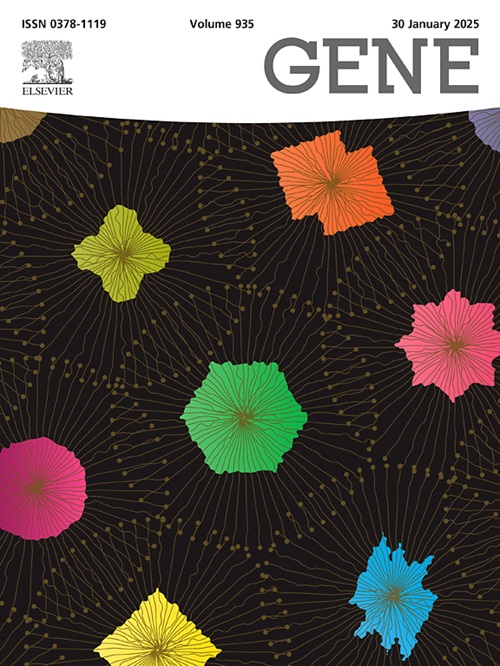Identification of oxidative stress-related hub genes for predicting prognosis in diffuse large B-cell lymphoma
IF 2.6
3区 生物学
Q2 GENETICS & HEREDITY
引用次数: 0
Abstract
Background
Oxidative stress is a cellular characteristic that might induce the proliferation and differentiation of tumor cells and promote tumor progression in diffuse large B-cell lymphoma (DLBCL).
Methods
The DLBCL gene sequencing dataset, tumor mutation burden data, copy number variation data of Somatic cell mutation data in TCGA were downloaded for data training analysis, along with four DLBCL datasets in GEO for validation analysis. The known oxidative stress related genes (OSRGs) were collected from websites. The weighted gene co-expression network analysis (WGCNA) was conducted on the TCGA DLBCL dataset to obtain gene modules related to oxidative stress and intersected with the known OSRGs to obtain the hub genes, which were used to perform consensus clustering on the samples to obtain new phenotypes. Next, the prognosis related OSRGs were selected through regression analysis algorithms and key genes were identified. These genes were used to establish the prognostic risk model and predictive model, and to compare functional and pathway differences among different risk groups.
Results
Through website search, we obtained 297 known OSRGs, and after intersecting with WGCNA results, we obtained 26 OSRGs. The TCGA-DLBC samples were clustered into 2 subtypes with these genes and there were significant differences in immune infiltration between subtypes. After regression analysis, we obtained a total of four key genes, BMI1, CDKN1A, NOX1, and SESN1. The risk prediction model established with these four genes as variables has accurate prognostic prediction ability. The key genes interact with 65 miRNAs, 57 TFs, 47 RBPs, and 62 drugs, respectively, and are closely related to immune infiltration of the disease. Among them, CDKN1A and SESN1 had the highest variability.
Conclusions
The key genes involved in oxidative stress could predict the prognosis of DLBCL and potentially become therapeutic targets.
鉴定氧化应激相关枢纽基因以预测弥漫大 B 细胞淋巴瘤的预后。
背景:氧化应激是弥漫性大 B 细胞淋巴瘤(DLBCL)的细胞特征,可能诱导肿瘤细胞的增殖和分化,并促进肿瘤的进展:氧化应激是弥漫大B细胞淋巴瘤(DLBCL)的一种细胞特性,可能诱导肿瘤细胞的增殖和分化,并促进肿瘤的进展:我们下载了TCGA中的DLBCL基因测序数据集、肿瘤突变负荷数据、体细胞突变拷贝数变异数据进行数据训练分析,并下载了GEO中的4个DLBCL数据集进行验证分析。已知的氧化应激相关基因(OSRGs)是从网站上收集的。在TCGA DLBCL数据集上进行加权基因共表达网络分析(WGCNA),以获得与氧化应激相关的基因模块,并与已知的OSRGs相交以获得枢纽基因,用于对样本进行共识聚类以获得新的表型。接下来,通过回归分析算法筛选出与预后相关的 OSRGs,并确定了关键基因。这些基因被用于建立预后风险模型和预测模型,并比较不同风险组之间的功能和通路差异:通过网站搜索,我们获得了297个已知的OSRGs,与WGCNA结果交叉后,我们获得了26个OSRGs。通过这些基因,TCGA-DLBC样本被聚类为2个亚型,不同亚型之间的免疫浸润存在显著差异。经过回归分析,我们共获得了四个关键基因:BMI1、CDKN1A、NOX1 和 SESN1。以这四个基因为变量建立的风险预测模型具有准确的预后预测能力。这些关键基因分别与65个miRNA、57个TF、47个RBP和62种药物相互作用,与疾病的免疫浸润密切相关。其中,CDKN1A和SESN1的变异性最高:参与氧化应激的关键基因可以预测DLBCL的预后,并有可能成为治疗靶点。
本文章由计算机程序翻译,如有差异,请以英文原文为准。
求助全文
约1分钟内获得全文
求助全文
来源期刊

Gene
生物-遗传学
CiteScore
6.10
自引率
2.90%
发文量
718
审稿时长
42 days
期刊介绍:
Gene publishes papers that focus on the regulation, expression, function and evolution of genes in all biological contexts, including all prokaryotic and eukaryotic organisms, as well as viruses.
 求助内容:
求助内容: 应助结果提醒方式:
应助结果提醒方式:


